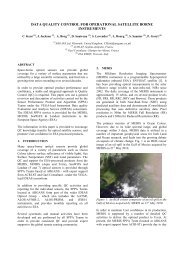SMOS L2 OS ATBD - ARGANS
SMOS L2 OS ATBD - ARGANS
SMOS L2 OS ATBD - ARGANS
Create successful ePaper yourself
Turn your PDF publications into a flip-book with our unique Google optimized e-Paper software.
ICM-CSIC<br />
LOCEAN/SA/CETP<br />
IFREMER<br />
4.16. Measurements selection (polarisation)<br />
191<br />
<strong>SM<strong>OS</strong></strong> <strong>L2</strong> <strong>OS</strong><br />
Algorithm Theoretical<br />
Baseline Document<br />
Doc: SO-TN-ARG-GS-0007<br />
Issue: 3 Rev: 9<br />
Date: 25 January 2013<br />
Page: 191<br />
This module describes how to select the successive MIRAS measurements for the<br />
computation of SSS, according to the polarisation mode chosen.<br />
To perform the iterative convergence, brightness temperature has to be taken in couples of H<br />
and V polarisations if the 1 st Stokes parameter is used, otherwise the two polarisations are<br />
included independently in the computations. The way to extract proper measurements is as<br />
follows:<br />
In case of Dual Polarisation: In a specific grid point all the snapshots that include it should be<br />
used, and this will include consecutively perpendicular polarisations. However, some of them<br />
can be invalid for SSS retrieval (either classified as bad by L1 or discarded in the <strong>L2</strong><br />
measurement discrimination) and as a consequence some pairs of horizontal (A1) and vertical<br />
(A2) measurements will not be formed.<br />
In case of using the 1 st Stokes parameter, and if the Scene Bias Correction (SBC, see module<br />
4.11) is applied, the H+V pairs have always to be organised by taking first an H measurement<br />
and its immediately consecutive V. Then if the first snapshot that includes a grid point<br />
provides a V measurement, this will not be processed. In case of lack of one or more<br />
measurements in the sequence, the order should not be changed and continue by coupling<br />
first A1 and then A2. With this selection method it might happen that some measurements are<br />
not used, in spite of providing good data.<br />
The following figure represents a couple of examples (grid points with very small number of<br />
measurements, for simplicity) from the first to the last view in a satellite overpass:<br />
*<br />
A1A2 A1A2 A1A2 A1 N N N N N N A2 A1A2 A1A2 A1A2 A1<br />
*<br />
A2 A1A2 A1A2 A1A2 A1 N N N A1A2 A1A2 A1A2 N A2 A1A2 A1A2 A1A2<br />
The brackets show the formed pairs of perpendicular polarisations in the most restrictive case<br />
(SBC with 1 st Stokes), while N means invalid measurements and red marks measurements<br />
that will be lost due to the measurement selection (lack of companion polarisation). If SBC is<br />
not applied, only measurements marked with * in the examples above are lost with 1 st Stokes<br />
option (end of a string with odd number of good data), as the order of complementary<br />
polarisations in a pair is not relevant. When the two polarisations are used separately, no<br />
good data have to be discarded, as pairs formation is not needed.<br />
When a correct measurement is not used in the retrieval due to this selection method, a flag<br />
on the measurement should be raised (Fm_lost_data).<br />
In case of Full Polarisation mode: do the same as dual polarisation, but taking into<br />
consideration only HH and VV measurements, not the mixed ones.<br />
The first Stokes value (I) is computed as described in 4.13.1.1.1 and 2 I = 2 A1+ 2 A2



